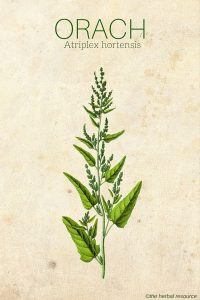During the Iron Age (c.1050 BC – c.500 AD) and the Middle Ages, orach was used both as food and medicine, and it is considered one of Europe’s oldest kitchen herbs. There are records that show that the herb was used in ancient Greece for ailments related to the “glands” and as a remedy for boils,
Henrik Harpestræng (died 1244), a Danish botanical and medical author recommended the herb for jaundice and shingles and the Danish humanist Henrik Smith (1495 – ca. 1563) wrote; “there are three kinds of orach, the bright green, the black and the red, and they all can be used in the kitchen as well as in the art of healing”.
It was believed that the crushed leaves soaked in honey water could cure jaundice and the red variety had the reputation of being used for ailments related to menstruation and the menstrual cycle.
Externally, the crushed leaves were used traditionally as wraps for minor wounds, cuts, and scrapes and to remove warts.
Medicinal Properties of Orach
Orach is considered to have invigorating, diuretic, emetic and laxative properties. Despite its medicinal properties it is a little-used herb in today’s herbal medicine
Since it belongs to the same family as spinach (Spinacia oleracea), it has many of the same medicinal properties and health benefits.
The herb stimulates nutritional uptake, and an extract (which does not taste particularly good) has been used as a spring tonic and an herbal remedy for fatigue and nervous exhaustion.
The herb has sometimes been used as a home remedy for sore throat and lung diseases and externally as a treatment for gout.

Leave a Reply